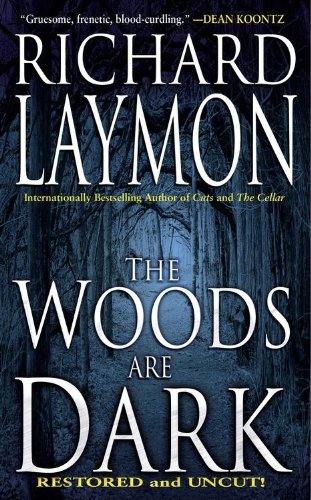 By RICHARD LAYMON (Leisure; 1981/2008)
By RICHARD LAYMON (Leisure; 1981/2008)
This is the “restored and uncut” version of THE WOODS ARE DARK, the second novel by the late Richard Laymon, and the one he maintained destroyed his career in the U.S. Specifically, the novel was heavily rewritten at the behest of its original publisher, leading to poor sales and an overall taint that overshadowed the remainder of Laymon’s career. This new version was prepared nearly thirty years after the fact by Laymon’s daughter Kelly, and apparently represents the original manuscript that Richard Laymon insisted could “never be pieced back together.” I’d like very much to proclaim it an unqualified triumph, but…
It opens promisingly, with two women driving through the woods of Northern California and encountering a strange figure who throws a severed hand at them. As was his custom, Laymon wastes no time setting things in motion, with the gals entering a diner and finding themselves locked in. Turns out they’re the latest in a long line of abductees intended as chow for the Krulls, a band of cannibalistic freaks who shun the trappings of civilization. Also on the Krulls’ menu is an upstanding high school teacher vacationing in the area with his wife, teenage daughter and the latter’s boyfriend. All, needless to say, are in for an education in savagery at the hands of the Krulls, who themselves aren’t entirely prepared for the full scope of the horror they unleash.
All well and good concept-wise, and accomplished with a degree of nastiness that’s extreme even by Laymon standards. Unfortunately the book has a very un-Laymon like sloppiness, with perfunctory and incomplete descriptions (toward the end a character thinks he sees a necklace of severed thumbs that, the narrative voice informs us, aren’t actually what they appear to be—yet we’re never informed what precisely the things are), choppy or nonexistent transitions (such as the mood-destroying news headlines that intrude in the final pages) and an ill-defined supernatural presence that has apparently lorded over the Krulls and for over 300 years yet is dispatched with remarkable ease.
This novel’s problems may be due to the fact that it was never very strong to begin with; there was probably a reason, in other words, that Warner Books felt the need to gut it all those years ago. Then again, the fault may lie with Kelly Laymon’s reconstruction of the text. In a lengthy introduction she reveals that putting this restoration together was an extremely labyrinthine process, and it’s quite possible she didn’t get it right. Perhaps Richard Laymon was correct in his claim that the definitive version of THE WOODS ARE DARK is indeed lost forever.
